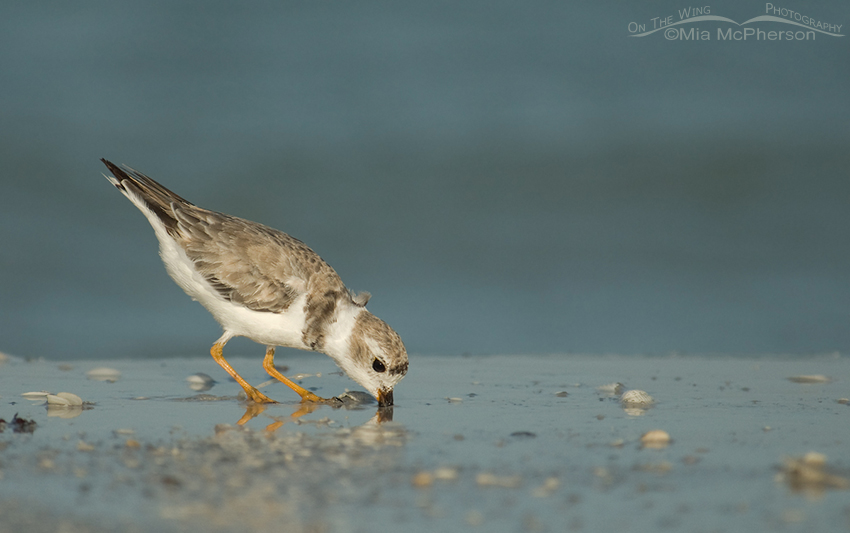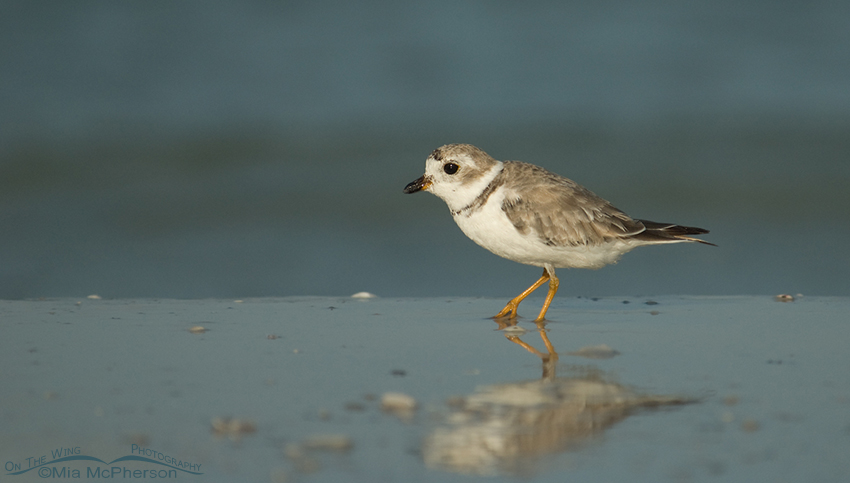These Piping Plover images were taken at Fort De Soto County Park in Pinellas County, Florida.
 Feeding Piping Plover (Charadrius melodus) – Nikon D200, handheld, f5.6, 1/2000, ISO 320, Nikkor 80-400mm VR at 400mm, natural light
Feeding Piping Plover (Charadrius melodus) – Nikon D200, handheld, f5.6, 1/2000, ISO 320, Nikkor 80-400mm VR at 400mm, natural light
Piping Plovers are small, pale shorebirds, they are about 7 1/4 inches in length with a wingspan of 19 inches. They can live up to 11 years. Their status is vulnerable throughout much of their range. There are two subspecies, one that is found along the Atlantic and Gulf coastlines and the other is an inland species.
When photographing shorebirds I like to get down to their level which usually means I am getting dirty. I will lay on the sand, mud, grass or get as low as I can in the water to get a low angle perspective. It can bring the viewer into the bird’s world but as a bird photographer I enjoy sharing that space with them too because it gives me a sense of intimacy with my subject.
 Piping Plover (Charadrius melodus) on the shore of the Gulf – Nikon D200, handheld, f5.6, 1/2000, ISO 320, Nikkor 80-400mm VR at 400mm, natural light
Piping Plover (Charadrius melodus) on the shore of the Gulf – Nikon D200, handheld, f5.6, 1/2000, ISO 320, Nikkor 80-400mm VR at 400mm, natural light
Piping Plovers nest in shallow scrapes in sand, gravel, salt flats or dunes which leaves their nests vulnerable to predators and in danger of being accidentally stepped on. The chicks are precocial and begin to run around not long after being born. They look like little tan cotton balls on stick legs. The feed on small mollusks, insects and marine worms in typical plover fashion, run, pause and pluck.
When I photographed this Piping Plover I was flat on my belly where the shallow waves of water pushed onto the sand. I have found that if I lay still enough the birds will approach me while I am “down & dirty”.
Life is good.
Mia
Click here to see more of my Piping Plover images plus facts and information about this species.


That low angle makes a huge difference in perspective. Nice background and reflection. I hope to see these little cuties when I am in Florida!
Julie, I hope you get to see Piping Plovers while you are in Florida too!
The angle really makes a difference, Mia! These are excellent images of this diminutive bird. I love how they skitter across the shoreline.
Julie, I love how they skitter too, they are such fun to photograph getting down to their level.
Piping Plovers are very neat birds and you took some excellent photos of them.
PrairieBirder, thank you very much for your comments on these images. Piping Plovers are really neat.
Mia, getting down and dirty has certainly paid off with excellent shots!
Thanks for your wonderful comment Katie!
You have really demonstrated how much difference it makes to get down on the birds’ level. I clearly need to work on that technique. I guess I need to get my waders out of storage. Lovely photos!
Linda, I never wore waders but I did wear clothes that dry very fast and ones that sand shook out of easily! Thanks for commenting.
I love your Plover shots Mia. They’re such pretty little things and they seem to exude gentleness.
“Gentle” is a word I think of when seeing Piping Plovers Laurence. They move with such grace and are so beautiful. Thank you for commenting.
Wonderful!!! I love the reflections and the POV is perfect!
Thanks Beverly!
What a great perspective! Gorgeous shots, Mia.
Thank you Scott, your comments are much appreciated.
I had that exact experience with the Green Heron in Arizona. When it comes to bird photography, that down on the level of birds on the ground perspective is the most captivating and interesting to look at. Though I’ve not been privileged yet to be under your direct tutelage in the field, I have learned some much from great photographers like you by reading your awesome blogs.
Thanks for commenting Robert. I loved your great low angle Green Heron shots from AZ.
We have to shoot together sometime!
I love the images Mia, taken from the low perspective really makes a difference.
Dan, thanks for your wonderful comment on these images.